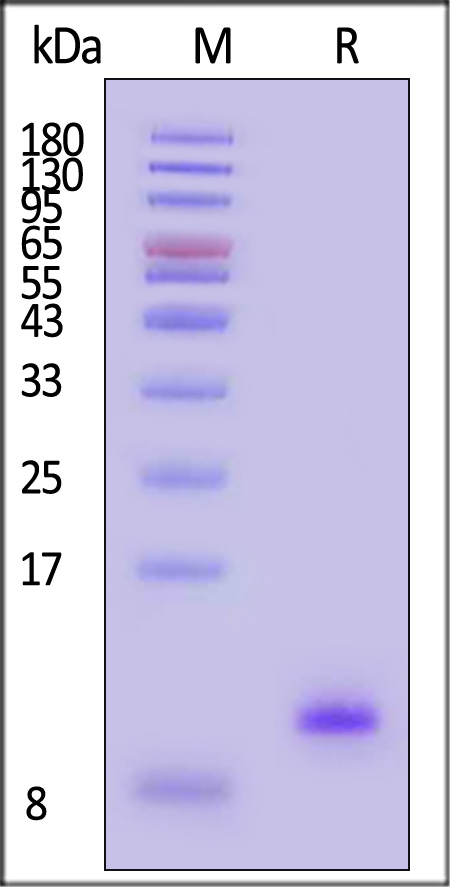分子别名(Synonym)
IGF2,C11orf43,FLJ22066,FLJ44734,IGF-II,PP9974
表达区间及表达系统(Source)
Human IGF-II Protein, His Tag (IG2-H5143) is expressed from E. coli cells. It contains AA Ala 25 - Glu 91 (Accession # P01344-1).
Predicted N-terminus: Met
Request for sequence
蛋白结构(Molecular Characterization)

This protein carries a polyhistidine tag at the N-terminus.
The protein has a calculated MW of 9.5 kDa. The protein migrates as 10-11 kDa when calibrated against Star Ribbon Pre-stained Protein Marker under reducing (R) condition (SDS-PAGE).
内毒素(Endotoxin)
Less than 1.0 EU per μg by the LAL method.
纯度(Purity)
>90% as determined by SDS-PAGE.
制剂(Formulation)
Lyophilized from 0.22 μm filtered solution in 0.085% TFA in 30%ACN with trehalose as protectant.
Contact us for customized product form or formulation.
重构方法(Reconstitution)
Please see Certificate of Analysis for specific instructions.
For best performance, we strongly recommend you to follow the reconstitution protocol provided in the CoA.
存储(Storage)
For long term storage, the product should be stored at lyophilized state at -20°C or lower.
Please avoid repeated freeze-thaw cycles.
This product is stable after storage at:
- -20°C to -70°C for 12 months in lyophilized state;
- -70°C for 3 months under sterile conditions after reconstitution.
电泳(SDS-PAGE)

Human IGF-II Protein, His Tag on SDS-PAGE under reducing (R) condition. The gel was stained with Coomassie Blue. The purity of the protein is greater than 90% (With Star Ribbon Pre-stained Protein Marker).
活性(Bioactivity)-SPR

Human IGF-I R / CD221 Protein, His Tag (MALS verified) (Cat. No. IGR-H5229) immobilized on CM5 Chip can bind Human IGF-II Protein, His Tag (Cat. No. IG2-H5143) with an affinity constant of 150 nM as determined in a SPR assay (Biacore 8K) (QC tested).
Protocol
背景(Background)
Insulin-like growth factor 2 (IGF-2) is also known as Somatomedin-A, IGF-II, PP9974, and is one of three protein hormones that share structural similarity to insulin. IGF-2 exerts its effects by binding to the IGF-1 receptor. IGF2 may also bind to the IGF-2 receptor (also called the cation-independent mannose 6-phosphate receptor), which acts as a signalling antagonist; that is, to prevent IGF2 responses. The major role of IGF2 is as a growth promoting hormone during gestation. In the process of Folliculogenesis, IGF2 is created by Theca cells to act in an autocrine manner on the theca cells themselves, and in a paracrine manner on Granulosa cells in the ovary. IGF2 promotes granulosa cell proliferation during the follicular phase of the menstrual cycle, acting alongside Follicle Stimulating Hormone (FSH). After ovulation has occurred, IGF-2 promotes progesterone secretion during the luteal phase of the menstrual cycle together with Luteinizing Hormone (LH). Thus, IGF2 acts as a Co-hormone together with both FSH and LH. IGF-2 may play a key role in memory and could potentially be used to treat Alzheimer's Disease. It is sometimes produced in excess in islet cell tumours, causing hypoglycemia. Doege-Potter syndrome is a paraneoplastic syndrome in which hypoglycemia is associated with the presence of one or more non-islet fibrous tumors in the pleural cavity. has been shown to interact with IGFBP3 and Transferrin.























































 膜杰作
膜杰作 Star Staining
Star Staining











